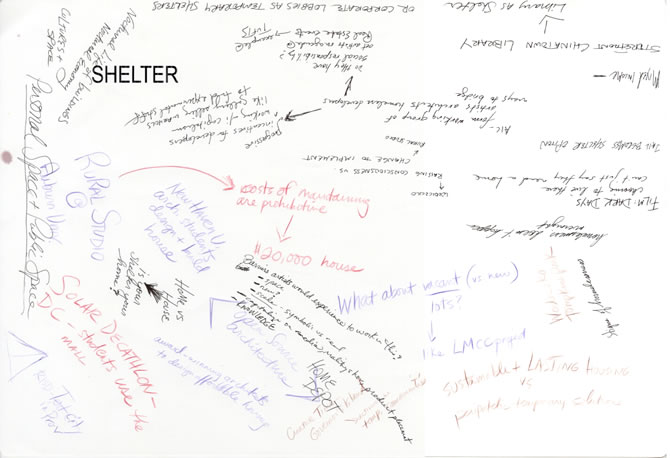Does shelter simply mean having a roof over one’s head? According to the National Policy and Advocacy Council on Homelessness, there are up to 100 million people worldwide who currently fit the description of being homeless. Of the 100 million, 20 to 40 million live without stable shelter in major city centers. The rising cost of housing and the shortage of affordable homes, now compounded by an unprecedented rate of property foreclosures in the United States, signal an even greater need to re-examine what it means to have shelter.
Nationally and globally, whether through natural disasters or political strife and violence, people are forced to flee from their spaces of dwelling. Years after Hurricane Katrina, it is an unfortunate reality that many people from the Gulf Region still cannot return. Despite the efforts of organizations such as the UN, refugees from Darfur, Somalia and other conflict-stricken regions remain uprooted and uncertain of their future. How can we as a society cooperate to solve this problem? How can we ensure that every person will have access to shelter– a place where one can feel safe and liberated?
View the Shelter Projects
Shelter Discussion at Launch Dinner Event

Notes on launch dinner Shelter Table placemat
Following the public AIC launch event on the afternoon of Oct. 9, 2009, approximately 64 people reconvened for a dinner/discussion event at MIT’s Stata Center dining room, organized by the Platform 2 artists’ collective. Each table focused on one of the eight themes of the Artists’ Prospectus for the Nation, assisted by a commissioned placemat by a New England-based artist (see the “Shelter” placemat below by Boston architect Meejin Yoon). An empty placemat at each table was used by diners to record notes from the discussion. Pictured directly above is the notated placemat from the Shelter Table.
Here is a summary of that discussion by one of the Shelter Table’s notetakers:
I tried to summarize our table’s conversation on the placemat (I was the scribe) so I think there you will find the most complete description of the Shelter conversation. A couple of things I remember:
- What is the difference between shelter/home/house?
- Homeless people may not want homes, i.e. there may be people that choose homelessness for certain reasons
- Rural Studio & other models which build homes for people – cost of maintaining these homes is sometimes prohibitive
- using corporate lobbies for temporary housing
- symbolic attempts at addressing Shelter (e.g. Wodickzko’s or Orta’s work) which raise awareness & spark imagintion vs. “real” attempts like Rural Studio – which is AIC interested in funding? both?
- shelter is like food – there is a lot to go around but not everyone that needs it gets it and there is a lot of waste – How to prevent so much waste? How to make use of what is already there?
- LMCC project to use empty spaces in NYC as temporary art spaces
Catherine D’Ignazio

Launch dinner Shelter Table placemat by Meejin Yoon


